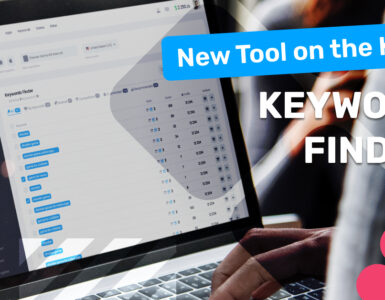Each app’s marketing strategy has unique goals that determine its success. For example, some apps focus on acquiring a large user base, while others prioritize generating revenue. But whatever the goal, it all starts with ASO (App Store Optimization), a set of actions aimed at increasing the visibility of your application on the App Store or Google Play. It’s a long-term process that should be implemented and measured to achieve and maintain sustainable organic app growth.
Let’s take a closer look at the main KPIs or metrics within ASO strategies, and learn how to measure and optimize them! As a result, you will uncover all the secrets of effective analytics and could use them for your app marketing strategy.
What types of ASO metrics exist?
If you’re involved in mobile marketing or app development, you might be wondering which ASO metrics to track. Here, we’ll explain how these metrics differ.
In general, the key ASO metrics are divided into:
• Internal, available only to the application developer. This is all the app statistics – impressions, views, installs, in-app purchases, user retention rate, and conversions. Developers can estimate the success of their efforts based on everything available on the console.
• External, available to users, developers, and third parties using mobile analytics tools. There are quantitative and qualitative external metrics of ASO optimization:
- Quantitative metrics include traffic, indexed keywords, app position in the keyword search results, and more. All of these can be calculated.
- Qualitative metrics, relying on quantitative ones, are aimed at analyzing the quality of the mentioned indicators. They provide insights into the user experience and the effectiveness of the optimization strategies.
Now let’s move from the general to the specific and examine the key performance indicators of the application in detail.
Key Performance Indicators (KPI) in Mobile Marketing
Visibility: Be Seen, Be Heard
Discoverability is a crucial element for an app’s success within the competitive app store ecosystem. It is a guiding light that directs potential users through numerous competitors to your app. This metric involves several complex components working together to enhance your app’s visibility.
Keyword Rankings. Keyword rankings serve as the primary strategy for boosting your app’s visibility. By thoroughly researching and integrating relevant keywords in your app’s title, description, and visuals, you improve its likelihood of appearing prominently in search results. App analytics platforms like Keyapp offer valuable data on keyword ranking performance, enabling you to fine-tune your approach and ascend the search rankings.
Category Rankings. Each app is associated with a particular niche, where its unique features stand out. Improved category rankings enhance the visibility of your app to users searching for similar functions, thereby increasing the likelihood of casual browsing leading to downloads. This ultimately increases the chances of being featured in the top rankings for that category.
Top Charts Rankings. Achieving a high position in the Top Charts can significantly elevate your app’s visibility and potential for viral success. It exposes your app to a wide audience, boosting downloads and increasing its reach. This increased visibility can lead to more organic downloads and a greater chance of monetization.
Appfollow platform
Featured Placement. Being selected for a prominent feature placement on the AppStore or Google Play can be compared to achieving remarkable visibility. This editor-selected position provides exceptional exposure, significantly increasing your app’s presence among numerous users. Keeping track of app store updates and understanding feature requirements can assist you in planning effectively for this valuable opportunity, maximizing your chances of gaining the editor’s attention.
How to Optimize App’s Visibility?
Remember, optimizing these metrics is not a one-time task; it’s an ongoing process of data analysis, A/B testing, and strategic adaptation. By updating your app store listing with relevant keywords, running user acquisition campaigns to improve keyword rankings, and creating an ASO strategy based on data-driven insights, you can make your app more discoverable. This will attract engaged users to your app and lead it to success.
Conversion and Growth Engagement
Once you’ve guided users through the competitive app store environment and captured their interest, the next important stage is conversion – turning fleeting curiosity into loyal downloads. This phase evaluates how well your app store listing convinces users to take the final step and install your app.
Conversion Rate (CR) and Click-Through Rate (CTR). These metrics are the cornerstones of conversion success. CTR gauges the effectiveness of your listing elements in driving clicks to the app page. CR measures the percentage of unique impressions that lead to app downloads. On the App Store, CR compares app units downloaded to unique impressions, while Google Play measures it as store listing visitors converted into purchases. Once users cross the threshold and download your app, the focus shifts to growth and engagement. This stage encompasses metrics such as:
Number and Velocity of Installs. Tracking the massive volume of downloads and their growth rate is crucial for understanding the overall popularity of your app.
Active Users (MAU and DAU). These metrics paint a picture of your app’s ongoing engagement, revealing how many users remain active on a monthly or daily basis. High MAU and DAU indicate a loyal user base, while strong growth in these metrics signifies successful retention and acquisition strategies.
User Acquisition (UA). A key metric that measures the amount spent on acquiring each new user. The lower UA indicates that you have more cost-effective acquisition strategies. Analyze how your UA campaigns contribute to download costs and optimize your strategies for maximum efficiency and return on investment.
How to Optimize App’s Conversion?
Focus on improving both conversion rate and click-through rate through strategic optimization. Target high-volume and low-competition keywords that accurately represent your app’s value proposition to drive higher CR. Experiment with different screenshots, design an eye-catching icon, and harness the power of positive user reviews to increase CTR. Continuously iterate and make data-informed improvements to enhance your app store page and establish your app as a market leader while significantly increasing conversions and driving more downloads.
Feedback is the Voice of User
Visibility and conversion are crucial for initiating your app’s success, but constant user feedback is essential for maintaining its growth. It provides unvarnished insights from your audience, highlighting the strengths, weaknesses, and areas for improvement in your app. This feedback comprises a range of metrics that can offer valuable lessons for enhancing your ASO strategy:
Rating Score. This numerical expression of user sentiment offers a quick snapshot of your app’s overall standing. A high rating signifies user satisfaction and fosters trust, while a low rating calls for immediate attention and strategic adjustments.
Number and Reliability of Ratings. The volume and reliability of ratings offer clues about your app’s current engagement and user pulse. A steady stream of recent ratings indicates active interest and potential trends, while a dwindling rate might signify declining engagement or outdated features.
Number and Quality of Reviews. Beyond the numerical score, the written reviews themselves are goldmines of qualitative data. Analyze the content and sentiment of reviews to identify recurring themes, user frustrations, and suggestions for improvement.
How to Optimize App’s Feedback?
Understanding these feedback metrics is crucial, but translating them into action is where ASO truly shines. Refine your strategy by addressing frequent user complaints and suggestions while updating app features to address usability issues. Showcase positive reviews and testimonials within your app store listing to build trust and encourage potential users to take the leap of faith. Respond to both positive and negative reviews as a demonstration of commitment to user satisfaction, strengthening community connection. By actively listening to your users, translating their feedback into actionable insights, and integrating it into your marketing strategy, you can optimize your app for long-term success.
Monetization: The Currency of App Success
The ultimate measure of an app’s success lies in its ability to generate revenue. This crucial stage measures the financial return on your ASO investment and the overall value your app delivers to users. Several key metrics highlight this financial aspect:
Revenue. This is the tangible outcome, the direct monetary return generated by your app through in-app purchases, subscriptions, or advertising revenue. Tracking trends in revenue growth helps you gauge your app’s financial health and identify potential areas for optimization.
Average Revenue per User (ARPU). This metric delves deeper, revealing the average amount of revenue generated per active user. A high ARPU indicates a successful monetization strategy and a loyal user base, while a low ARPU might suggest pricing adjustments or improved user engagement strategies.
Lifetime Value (LTV). This metric takes a long-term perspective, estimating the total revenue a user will generate throughout their engagement with your app. Understanding LTV helps you make informed decisions about user acquisition, retention strategies, and long-term investment.
How to Optimize App’s Monetization?
To ensure long-term financial success and healthy monetization, consider ASO-driven strategies. These include in-app purchase optimization, targeted user acquisition, engagement-driven features, and data-driven decision-making. In-app purchases should offer clear value propositions and address user needs, while targeted user acquisition focuses on acquiring high-purchasing potential users. Engagement-driven features encourage continuous user engagement and incentivize further monetization opportunities. Data-driven decision-making uses analytics tools to track user behavior, revenue trends, and performance metrics. Combining these strategies can transform an app from a free download into a revenue generator.
Top 5 Tips on How to Analyze ASO Data Effectively
Collecting data for ASO is not enough; you need to interpret it skillfully. Analyzing ASO data effectively helps identify what’s working, what’s not, and how to improve. Here’s how you can analyze ASO data effectively and draw meaningful insights:
1. The quality-quantity pair of an application’s ranking is crucial for determining growth. If an app has +44 new words indexed, it indicates an increase in quantitative standards, but if the position is not in the top 50 or at least the top 100, it indicates no growth from a qualitative point of view. Analyzing qualitative and quantitative indicators in the context of each other is essential.
2. The traffic-conversion-settings trio should not be overlooked, as missing any part of the chain can hinder goal achievement. If an application is indexed, installed, and deleted by the user, it is important to analyze and fix the issue.
3. External factors should not be overlooked when evaluating ASO optimization. While it is necessary to identify reasons for low performance and other issues, it is not always necessary to solely blame ASO. It is important to consider the market and its users, as well as the ASO strategy itself. For example, a fitness app indexed for “fitness at home” during global quarantine may not be relevant in the post-quarantine world, where people are allowed to leave the house.
4. Iterations of ASO optimization involve changes in the visual and text parameters of the app, based on the statistics of various KPIs. For instance, changing the app icon (visual) may lead to an increase in installs, but what specifically led to success should be considered. Therefore, optimization should be phased, preferably step by step, and not changed in one optimization.
5. Identify trends and patterns. Look for trends in your ASO data. If there’s a spike in downloads, investigate what caused it. If there’s a drop in user retention, analyze user feedback to pinpoint issues. By observing patterns, you can predict future performance and make proactive adjustments, and cohort analysis is perfect for this.
To sum up, there are no single KPIs or metrics that can measure the overall success of an app. All of them are equally important, not only on a certain product stage but also as an integral part of the greater App Store Optimization strategy. Only by studying all these metrics, and combining them together, we can get a complete picture of the performance.
The success of every mobile app is never built overnight – it takes a lot of time and work, and it’s all about a deep understanding of the processes, measurement of the results, and analyzing the effectiveness of the certain marketing actions we perform. Leverage the power of data to your advantage, study the key metrics, attribution partners, app intelligence, and ASO tools – and your mobile growth strategy will be unbeatable!






















